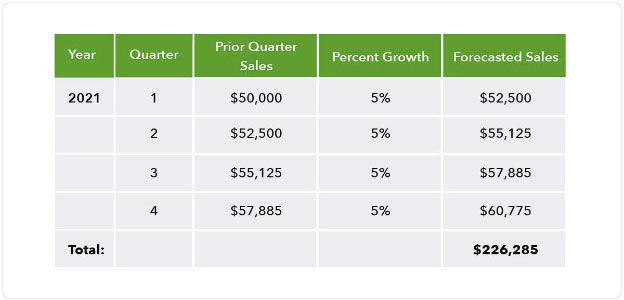How to forecast sales
We’ve covered some of the most popular forecasting methods. But when it comes to actually digging into the numbers and pulling together your own sales forecast, here are the steps you need to take.
1. Know your timeline
Your sales forecast predicts your future sales. But how far into the future? Are you trying to figure out what your sales will be for the next month? The next quarter? Next year?
Before you dig into the numbers, you’ll need to know what sort of time period you’re looking at.
If you’re including your sales forecast in your business plan, it’s smart to predict sales for each month over the course of the next year. Then you can estimate sales per year for the next three to five years.
EXAMPLE: We’re forecasting sales for the next month.
2. Choose a sales forecasting model
Next up, you’ll need to pick the sales forecasting method you want to use. When choosing a method for your business, consider:
- Type of your business: Do you have a brick-and-mortar location?
- Age of your business: Do you have historical data to reference?
- Access to data: What sales data or market research can you get your hands on?
- Sales process: Do you have an established sales flow or pipeline to monitor?
Still not sure which forecasting model is right for you? Don’t be afraid to test out a few different ones to figure out which one works best.
EXAMPLE: We’ll use a historical sales forecasting model as a predictive indicator of our future sales for the next month.
3. Run the numbers
Once you’ve landed on a model, you’re ready to run the numbers. Make sure you get the data you need. In the case of our example, you’ll need to pull reports from your accounting software to understand your historical sales performance.
Imagine that you made R25,000 in revenue last month and sales have consistently been growing 2% over the prior month every month.
Using that information, you’d use this formula to project sales for the next month:
Monthly revenue x (1 + % growth) = forecasted sales
In the case of our example, that would look like:
R25,000 x 1.02% = R25,500
EXAMPLE: We’re forecasting R25,500 in revenue over the course of the next month.
4. Set your sales quotas
Now that you have a better handle on what’s possible for your business, it’s important that you set a benchmark for success. Use your sales forecast to establish sales quotas to work toward.
You could set a monthly quota, quarterly quota, or even an annual quota. In addition, you could set an overall quota or individual quotas for each of your team members. It’s wise to set a quota a little beyond your forecast, so you give your team something to work toward.
EXAMPLE: The sales team should achieve R26,000 in sales by the end of next month.
5. Prioritize transparency and accountability
Keep in mind that a forecast is an educated guess, which means it’s your job to monitor your sales performance and see how close to your forecast and goals you come.
You should also include your team members in those updates, so they understand their progress toward their own sales quotas.
It can be helpful to invest in a customer relationship management (CRM) platform to track all of your customer data and keep your team on the same page about how you’re doing.
6. Learn and evolve
You might surpass your forecast and quotas, or you might fall short. Keep in mind that this is a learning process.
Take the time to reflect to see how accurate your predictions and goals were. If they were way too aggressive, then maybe you want to try a different forecasting method.
Remember that making improvements and adjustments over time is all part of the forecasting process.





